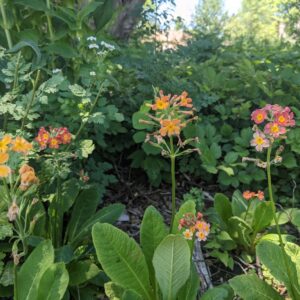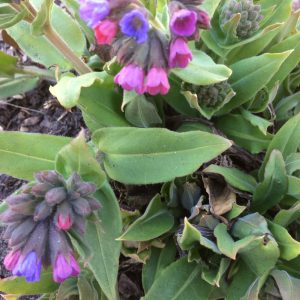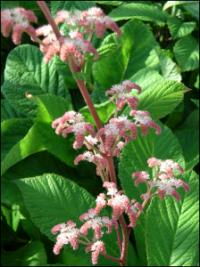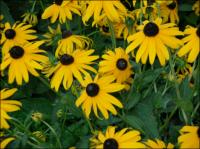Deer Resistant Plants
Showing 113–120 of 163 results
-
Primula x bulleesiana Candelabra primrose Z 4-7
From clustered stems, each bearing a whorl of 3-6 flowers encircling each leafless stem alternating with a bare section of leafless stem, then another whorl of flowers, then another section of bare stem, in tiers, like a ballerina’s tutu with bare midriff between. Each whorl blooms in succession from the bottom up. This blooms June – July in a rainbow of colors - red, orange, rose, cream, lavender and purple.
OUT OF STOCK
From clustered stems, each bearing a whorl of 3-6 flowers encircling each leafless stem alternating with a bare section of leafless stem, then another whorl of flowers, then another section of bare stem, in tiers, like a ballerina’s tutu with bare midriff between. Each whorl blooms in succession from the bottom up. This blooms June – July in a rainbow of colors – red, orange, rose, cream, lavender and purple.
Size: 18-24” x 12-18”
Care: Sun to part shade in moist to well-drained soil
Wildlife Value: Attracts butterflies. Deer resistant
Awards: Royal Horticultural Society Award of Garden Merit 1993Hybrid cross between Primula bulleyana and Primula beesiana (both parents are native to the Himalayas and China).
Collected in China, introduced to Britain in 1906 -
Pulmonaria angustifolia Narrow-leaf lungwort, Blue cowslip Z 4-8
One of the earliest to flower - Pink turning azure blue, trumpet-shaped flowers in April- May. Fuzzy foliage.
Welcome spring with this very early flower – Pink trumpet-shaped flowers turn deep blue in early sprng.. Fuzzy foliage.
Size: 12”x 12”
Care: full to part shade in moist to moist well-drained soil.
Native: Austria & Hungary.
Wildlife Value: walnut and deer tolerant. Early source of nectar for bees.
Awards: Royal Horticultural Society Award of Garden MeritAngustifolia means “narrow leaves.” Grown in gardens before 1590’s.
-
Pulmonaria saccharata ‘Mrs. Moon’ Greater lungwort, Bethlehem sage Z 3-8
In early spring funnel form pink flowers turn to blue above bristly, white mottled green foliage. Leaves attractive through fall
OUT OF STOCK
In earliest spring funnel form pink flowers turn to blue above bristly, white mottled green foliage. Leaves attractive through fall
Size: 8-18” x 18-24”
Care: full to part shade in moist well-drained soil
Native: species France & Italy
Wildlife Value: walnut and deer tolerant. Early source of nectar for bees.The species originally described by English botanist and gardener to Queen Mary, Leonard Plukenet (1641-1706) .Described by Philip Miller (1768) as having “spotted leaves as if they were incrusted with sugar.” ‘Mrs. Moon’ cultivar offered for sale in 1938 by Gardenside Nurseries in Shelburne VT. Name Pulmonaria from Latin pulmo or lung (e.g.today’s pulmonary) because the blotched leaves were considered to resemble lung disease. Saccharata comes from Latin word for sugar because the white bristly leaves resembled sugar coating.
-
Pycanthemum muticum Clustered Mountain Mint, Blunt Mountain Mint Z 4-8
Silvery bracts underlying silvery-pink pincushion flowers blooming from June to September. Flowers and leaves emit a minty fragrance.
Silvery bracts underlying silvery-pink pincushion flowers blooming from June to September. Flowers and leaves emit a minty fragrance.
Size: 12-36” x 12-36” spreading.
Care: sun to part shade in moist to well-drained soil, drought tolerant
Native: Maine to Michigan, south and angling southwest from Wisconsin to Texas
Wildlife Value: Deer resistant. One of highest nectar and pollen producing flowers, attracting copious numbers and kinds of bees, butterflies, wasps, and other insects.
Awards: Georgia Native Plant Society Plant of the Year 2022, Perennial Plant Society of the Year.Collected and described by French botanist André Michaux (1746-1802) who spent 11 years exploring the North America for plants. c. 1795.
-
Ranunculus acris Meadow buttercup Z 4-8 POISON
Scads of cheerful cup-shaped, butter-colored blooms atop wiry stems in late spring to early to mid- summer. Flowers taller than the deeply divided foliage into 3-5 hand-shaped lobes, each of which it divided again into more lobes with sharp-shaped tips with tooth-like edges all with prominent veins. Excellent cut flower
Scads of cheerful cup-shaped, butter-colored blooms atop wiry stems in late spring to early to mid- summer. Flowers taller than the deeply divided foliage into 3-5 hand-shaped lobes, each of which it divided again into more lobes with sharp-shaped tips with tooth-like edges all with prominent veins. Excellent cut flower
Size: 18-24” x 12” slowly spreading
Care: Sun to part sun in moist soil
Native: Europe
Wildlife Value: deer resistant, attracts butterflies and bees.Ranunculus is Latin for little frog, so named by Roman Pliny referring to the wet conditions required by some ranunculus. Named by English naturalist John Ray in Historia plantarum, published between 1686 and 1704, in which he classified 18,000 plant species.
-
Rodgersia pinnata Rodger’s flower Z 5-8
Ground-hugging mound of bold leaves arranged opposite one another along the stem (pinnate, this is why it’s called pinnata) appear to be arranged in the shape of a hand (palmate) because the leaves are so large it’s hard to see the difference. To translate, the leaves are a sight to behold featuring their big size, crinkled texture, and, dark veins. This blooms on a stalk about a foot taller than the leaves in July-August pink, sometimes white.
Ground-hugging mound of bold leaves arranged opposite one another along the stem (pinnate, this is why it’s called pinnata) appear to be arranged in the shape of a hand (palmate) because the leaves are so large it’s hard to see the difference. To translate, the leaves are a sight to behold featuring their big size, crinkled texture, and, dark veins. This blooms on a stalk about a foot taller than the leaves in July-August pink, sometimes white.
Size: 3' x 30" and slowly spreading by rhizomes
Care: shade in moist soil
Native: China
Wildlife Value: deer resistant.
Awards: England’s Royal Horticultural Society Award of Merit & Elisabeth Carey Miller Botanical Garden Great Plant PicksRodgersia named for American Admiral John Rodgers (1812-1882) who led an expedition in the Pacific in 1852 during which the 1st species of this genus was discovered. This species introduced from its native China by Ernest “Chinese” Wilson (1876-1930) by 1910.
-
Rudbeckia subtomentosa ‘Henry Eilers’ Z 4-8
These Rudbeckias tower above basal leaves on rigid, branching stems forming clumps of sun yellow petaled flowers surrounding a raised, brown dome of disc flowers. But instead of flat petals, the petals are rolled into narrow tubes, looking like many spokes of a wheel blooming from mid-summer into fall.
OUT OF STOCK
These Rudbeckias tower above basal leaves on rigid, branching stems forming clumps of sun yellow petaled flowers surrounding a raised, brown dome of disc flowers. But instead of flat petals, the petals are rolled into narrow tubes, looking like many spokes of a wheel blooming from mid-summer into fall.
Size: 3-5’ x 1-2’
Care: sun in moist well-drained soil
Wildlife Value: attracts butterflies, deer resistantHenry Eilers discovered this cultivar while scouting a southern Illinois prairie. Here is his story.
Henry Eilers, born in 1934, long-time nurseryman, had introduced selections of different ornamental plants that he found growing at his nursery. But Rudbeckia subtomentosa ‘Henry Eilers’ is different. Henry worked tirelessly for decades to preserve Illinois plants and their diversity. In the early 1980’s while scouting a prairie remnant near Witt in Montgomery County IL he spied a small clump of uncommon Black-eyed susan. Instead of the usual broad, flat petals, this one has narrow, quilled petals. He dug it and replanted it at his nursery where it grew on. It still grows in his wildflower garden. He decided to name it Rudbeckia ‘Montgomery County.’ In the 1990’s Henry took it and other native wildflowers to a native plant sale at the Shaw Arboretum, Missouri Botanic Garden. He and another nurseryman, Larry Lowman exchanged a few plants, one being this Rudbeckia. Several years later he found it for sale in the Plant Delight’s Nursery catalog, renamed Rudbeckia ‘Henry Eilers.’ Over time the plant appeared in gardening magazines and mail order catalogs. It now grows in the entrance planting at the National Botanic Garden in Washington, at the Missouri Botanic Garden and the Brooklyn Botanic Garden. A nurseryman from the Czech Republic told Henry he had been growing it! -
Rudbeckia subtomentosa Sweet coneflower Z 4-8
These Rudbeckias tower above basal leaves on rigid, branching stems forming clumps of sun yellow petaled flowers surrounding a raised, brown-purple dome of disc flowers.
These Rudbeckias tower above basal leaves on rigid, branching stems forming clumps of sun yellow petaled flowers surrounding a raised, brown-purple dome of disc flowers.
Size: 4-5' x 1-2'
Care: Sun to part shade in moist to moist well-drained soil
Native: East US, Wisconsin native.
Wildlife Value: attracts butterflies, deer resistantRudbeckia was named by Linnaeus for his University of Upsala professor, Olaf Rudbeck. Rudbeck made the surprising claim “that the Paradise of Scripture was situated somewhere in Sweden.” C.F. Level. This species described in 1815. May have been collected by English planthunter John Bradbury (1768-1823).






